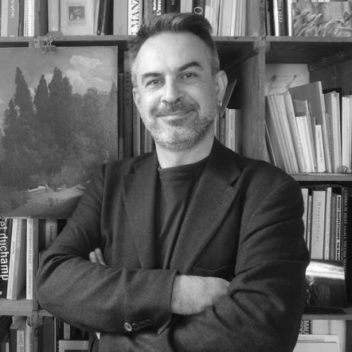
The Book of Shares Giorgio Mastinu
Italian Journey
One of the most famous portraits of Goethe shows the poet in the Roman countryside in a pensive moment during his travels in Italy. At his side, a few artifacts: archeological remains, parts of an Ionic capital, the blocks of stone on which he is seated, and,
in the distance a tower and the vestiges of time-worn architectures. Fragments counterpointing Nature, trees, bushes, grasses and a morning glory docilely winding over the figures carved in the white marble of a low relief. The man, the poet, the artist,
is reclining on the diagonal of the painting—one leg and foot firmly set on the ground (even his hand seems to restrain it) whereas the other rests on the blocks, with foot poised, almost balanced—connecting what belongs to Nature with what belongs to thought, to Art.

Tischbein, J. H. W. Goethe in the Campagna, c. 1787.
A new geology
Ever since his first works Arienti has been poised between Nature and Thought. From the Muffe and the Alghe (1985–86), Disegni dei Maestri (1989) and up to his latest experiments— of which Biblioteca (Library) is the quintessence—Arienti’s Nature conjures itself and finds new ways of being present in the real world. Elaborate forms, mineral inventions, or in botany of trees, leaves and flowers, or in zoology, and even evocations of stars or planetary conjunctions, elements that partake in his poetic, plastic, pictorial mediation in the world. The raw material organizes itself in utterly simple or complex ideas, performs processes of generation, of controlled transformation, resulting from an action, manipulation, motion, change of condition, new disposition, new form. Biblioteca is logos, speech, principle, connection, proportion, measure, raison d’être, design. Logos whose classical root is Léghein: to choose, tell, count, but also assemble, preserve, receive speech: to listen. In Heraclites it is fire itself, the generating principle of reality (how not be reminded of the one that fires the tomes of Biblioteca?). A live and active principle that shapes inert matter, rousing it and giving it life. Similarly Biblioteca’s new geology: crystallized earth, matter composed (recomposed) of geological sediments, in formations and aggregations, in elaborate or utterly simple lithological groups, aroused and rendered vital, but solidified, as if congealed. Structures, traces of life, fossils, visible or encased between one block and another in a colloquy between iconology and ichnology, where image (eikon) and trace (ichnos) become logos (discourse), materialized in this new form of a book. A process of Mimesis—but of mimicking as well—of Nature in Nature, where the manipulation of the image, the “copy of a copy”, is performed by stratification (the book cover, already a copy, image, is in turn photocopied and then transferred—copied—with pounce on the wet clay tablets). Over and over Arienti dismounted, cut, manipulated, hid the books, now he creates them anew in a material that defies time. So Biblioteca is Mimesis, but Methexis as well, participation of the things of the tangible world with that of ideas, where the “relational practices” in Arienti’s production assume different meanings. The selective process of the elements of the work (the books composing it are chosen by him and his patrons) is participative and shared, the “game” of the pricked pouncing holes is the outcome of a collaboration, just like the reordering of the perforated blocks in Garrison Woods. A game that does not involve hierarchies but simple choices of fondness, in a shared dialogue, with Nature as well. Some parts of the story will come to light, others remain hidden, enclosed, secret. Revealing something the earth concealed: Arienti himself underscores one of the premises of Biblioteca, memory: “what is inside the book is in your mind”. The ceramic artifacts in museums tell us much about esthetics, lifestyles, in the case of common objects (bowls, vases, amphorae) even of the everyday familiar life. They are the remains of a civilization, “almost an archeology”, not only of “excavation” but of “memory” and discovery of this mute, secret alphabet: ornament as writing. Here the dot, the hole as the aim of abstraction is returned to its earthly dimension, no longer Fontana’s “spatialism” but almost a Land Art operation (even through being a work en plein air), and yet a denial (on American Land) of minimalism, with an almost “literary” response to Carl Andre’s works in bricks.
Natura, non artis opus: plants, flowers, fruits, birds, natural and urban landscapes, abstract arabesques, alphabets, are encased in these “caprices” of mineralogy. The precise architectonic and geometric relations of these “sculptures” call forth the sense of the real and the metaphorical with endless suggestive opportunities. Biblioteca has almost a ritual dimension, in the different arrangements of the blocks, of the tomes rising from the ground, their invitation to peruse them, and linger, and listen with them to the murmur of Nature, the wind on the leaves of the trees and the twittering of the nearby birds or the surge of abstract silence when in winter they will be cloaked in snow. These books of Arienti’s will grow roots. We can fancy that not too far from now they will become cozy dens for tiny animals, insects, will take on color by supporting molds, lichens, maybe corals in a thousand years. Almost as to elucidate the magic, a small antique bust, in earthenware, kindles and observes in silence this primordial place of feeling.